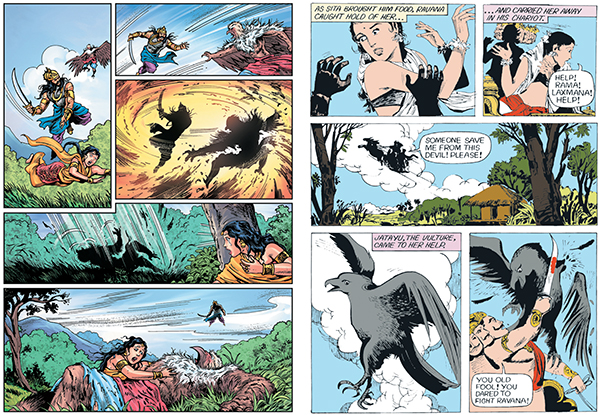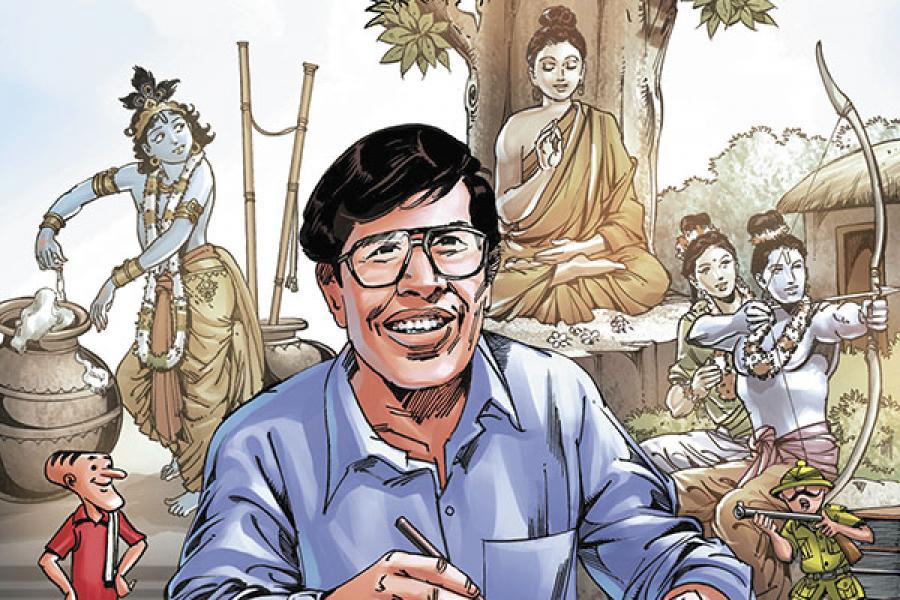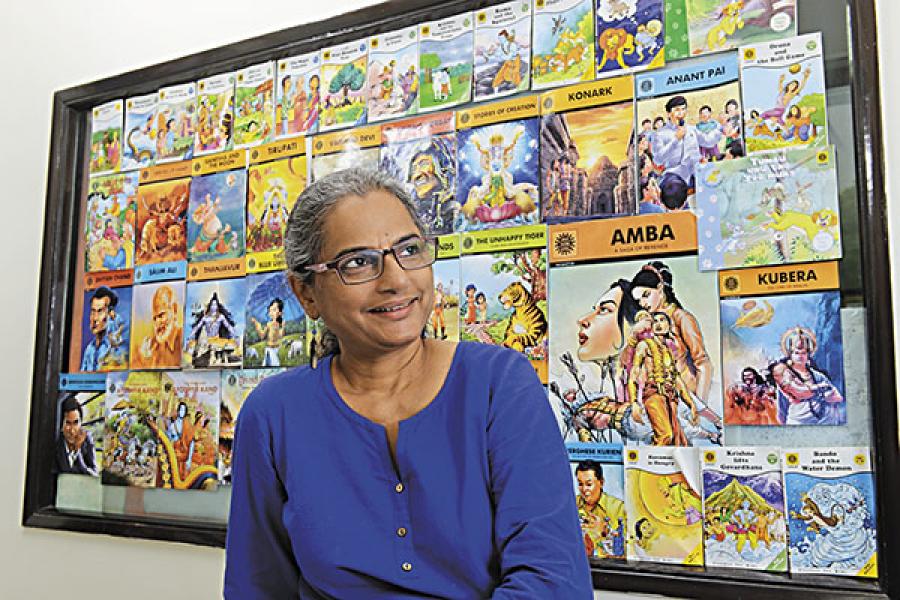
How Amar Chitra Katha is going back to the future
As Amar Chitra Katha prepares to turn 50, it is retracing its steps to what it has always done best—telling stories
One of the most enduring tales within the Amar Chitra Katha (ACK) family is that of founder Anant Pai, sitting among children, reading from one of the much-loved comic books, and enthralling his young audiences. It is, therefore, fitting that as ACK prepares to celebrate its golden jubilee next year, it is in the process of retracing its steps to what Pai held close to his heart, and was so good at—old-fashioned story-telling.
Coming up over the next year will be a series of events held across several malls in different cities, which will seek to recreate Uncle Pai’s (as the comic’s creator is fondly known) story-telling sessions. Malls may seem like an unlikely venue for Pai’s gathering of schoolchildren, but not only are they the modern-day spaces for community activities, ACK also has the backing of one of India’s largest retailers: Kishore Biyani’s Future Group bought a minority stake in ACK Media in March 2011, followed by a majority stake in July 2011. (Elephant Capital holds the minority stake.)
Those within the company point to Biyani’s attempts at producing films—Na Tum Jaano Na Hum (2002), starring Hrithik Roshan, Saif Ali Khan and Esha Deol—as indicative of his inclination towards creative ventures. But, creativity apart, the founder and group CEO of Future Group, which owns hypermarket chain Big Bazaar, is also said to have a deep love for everything Indian. And what can be more Indian than Amar Chitra Katha, which has also been published in more than 36 languages and distributed in 12 countries.
“We are thinking of a big mela where we create an environment of fun and storytelling,” says Anuraag Agarwal, head of strategy, mergers and acquisitions at Future Group, who has been the interim CEO at ACK for the past six months. “We plan to have workshops with parents and children; there will be a character parade, ACK selfies and the trademark ACK Quiz.”
The event is representative of ACK’s efforts to go back to the basics—tell stories and engage with their readers—after having meandered for a bit in its quest to stay relevant. “Over the last few years, there were some efforts to enter the animation sector, and go on to digital platforms,” says Agarwal, speaking of the two films—Tripura (2011, premiered on Cartoon Network) and Sons of Ram (2012, released in theatres)—the YouTube channel and the app launched by ACK Media. “But there was not enough push within the company to make these a success. We also learnt some things along the way: Such as, a lot of children don’t really have access to apps, and a lot of parents would rather have their children read books than sit with an electronic device. So we are focusing on our books once again.”
It would be interesting to see what this renewed focus does to a product that, without any marketing push, has managed to sell an average of 5 lakh copies every month since 2013-2014. This shift in approach, however, has meant a rejig within the Future Group departments that have been trimmed—many of ACK’s old-timers are no longer with the company—to make them more agile, to flatten the hierarchy within teams and increase interactivity between them. Agarwal himself divides his time between handling mergers and acquisitions, and managing ACK, a job that he seems to thoroughly enjoy. “Where else can you read comic books as part of your job?” he laughs.
Agarwal says there is a “contra-trend” among readers who want their children to read more of Indian content rather than Western. “People want their children to be familiar with their roots,” he says.
This is exactly what had prompted Uncle Pai to start Amar Chitra Katha in the first place. The legend goes that Pai, who passed away in 2011 at the age of 81, and his wife Lalita were walking along Delhi’s Karol Bagh area when they came across a shop where a quiz show was being telecast on TV, still a novelty in India. As they joined the small crowd gathered outside the shop to watch the programme, the quizmaster asked: “Who is the Greek god of the seas?” One of the teams answered, “Poseidon.” However, the next question—“Who is Ram’s mother?”—stumped the participants.
Pai saw such uncertainty about India’s mythology in his nephews and nieces too. He realised that youngsters in India were growing up on a diet of Western culture and information, and remained oblivious to the riches of India’s mythology, heroes and legends. Thus began his lifelong endeavour to tell the country’s greatest stories to its children.
“Whatever ACK is, is because of the vision of Uncle Pai,” says Reena I Puri, executive editor of ACK Media, and a 25-year veteran of the company. “He did not start it as a money-making enterprise. He wanted to reach out to the children of the country through our story-telling heritage.”
Pai had worked with the books division of Bennett Coleman & Co, when they had launched Mandrake and Phantom under the Indrajal Comics series in 1964. With the urge to start a series on Indian comics, he approached the Mirchandanis of India Book House (publishers and distributors of books and magazines since 1952), who agreed to become distributors of Pai’s comic books. Thus, Amar Chitra Katha was born in Mumbai in 1967. “They agreed to give Uncle Pai a space to work in and also promised to print what he created, although, at that time, they did not pay him a salary,” says Puri. The first title to be published—scripted by Pai, and illustrated by another much-revered name, Ram Waeerkar—was Krishna, in 1970.
After struggling for the first five years—during which Pai took to the road with a suitcase full of comic books every day, even putting up display shelves in bookshops—ACK started breaking even and gaining popularity.
By 1980, ACK had published 400 titles, covering mythological tales, historical figures and modern-day legends. What became one of the defining characteristics of these publications—apart from their iconic artwork and narratives (see: The art of the matter)—was the research that went into each story. And although there have been tweaks to artistic styles over the years, the effort to gather accurate information holds as strong today as it did then.
Puri and her team, who are working on a new series of the Ramayana—it will now be published according to the different ‘kands’, such as Bal Kand and Ayodhya Kand—have for reference Valmiki’s Ramayana. “We chose to stick to the original Valmiki Ramayana instead of opting for any other version, such as Tulsidas’s Ramcharitmanas,” says Puri. “Valmiki’s vision and his detailed description are so splendid that you don’t even need to think of how to visually depict a scene; all you have to do is follow what he has said.”
This process of research takes on a more personal approach whenever ACK writes about modern-day heroes. “We have to get the consent of their families, because we need details and snippets that only a family member or a close friend can give. These are the small details that make a story more appealing to children,” says Puri. So, it becomes necessary to figure out what the protagonists of these stories were as children, what they ate, what they wore. “It is even important to understand what the walls of their childhood homes looked like,” says Puri.
When ACK came out with their book on Mother Teresa in 2010, for instance, the Missionaries of Charity (the organisation she had founded in Kolkata) did not agree to give formal interviews, but said they would rather show by their work what Mother had taught them. “Shalini Srinivasan, the scriptwriter, volunteered and stayed with the sisters and, while they worked, they shared the most delightful stories about Mother,” says Puri.
In a departure from his focus on mythological tales and historic characters, Pai started Tinkle in 1991 to focus on fun and learning. Reprints of older ACK titles, meanwhile, continued unabated. Demand for the books has always been distributor-led. “It is our distributors who give their feedback to our sales team about which books are selling out, and, thus, need to be reprinted,” says Puri. “They are also the ones to tell us whether we should print a certain story in a specific regional language because readers have been asking for it.”
ACK readers have almost felt entitled to make such demands. “There was a time when, for Tinkle, we would get more than 10,000 letters every summer, when schools closed and children got the time to write,” remembers Puri. “And these letters, scrawled by children, were often on scraps of paper torn off note books.” The letters included stories, jokes, and sometimes even complaints about parents not understanding them. They regarded Tinkle and Amar Chitra Katha as a friend and felt free to confide in their Uncle Pai.
Today, this fan following has been transported to ACK’s Facebook page, which has more than 1.69 lakh ‘likes’. “Even today, we get suggestions about the stories that we should work on and publish, along with some researched material as well,” says Sanjana Kapur, assistant editor at ACK. “There are even arguments that break out among different readers, but we stay out of that.” This increased engagement is hardly one-sided: ACK regularly posts quizzes and competitions, interesting videos and nuggets of information on the page, keeping up a constant flow of engaging content.
But involvement with readers—who, by now, span a few generations—is not just an online activity. Uncle Pai’s fascination for telling stories to children and holding quiz contests has endured through the years. ACK is a regular at events such as Bookaroo (Delhi), World Book Fair, Comic Con (Delhi, Mumbai, Bengaluru), Dehradun Festival (though not every year) and Ghumakkad Narayan in Dehradun, where they put up stalls, hold workshops and contests. This is where the generations-wide readership becomes even more obvious. “We see parents competing with their children, and scrambling to answer questions and win contests,” laughs Puri.
ACK also aims to focus more on its school outreach programme, where the publication holds events with children in different schools. “We want to make it bigger and better. We never really stopped going to schools and conducting workshops but it was not organised,” says Puri. “We hope to streamline the process and go to more towns and cities this year. We’d like to connect with a minimum of 1.5 lakh children in this academic year.”
The appeal that ACK holds across generations is something its new management has woken up to and is now aiming to take advantage of, as it looks at a 50 percent year-on-year growth, it says. Otherwise you would not have somebody like Suppandi—the simpleton from Tinkle—dabbling with the basics of investing in a comic-book style publication by Tata Mutual Fund. “The idea was that if Suppandi can understand it, anyone can,” says Future Group’s Agarwal. “It is also something that children can read and understand.”
As part of this tie-up, around 67 lakh booklets were translated (into English, Kannada, Hindi, Bengali and Tamil) and distributed along with major newspapers, and business magazines. All Tata Group companies were given copies of the booklet to be distributed among their employees. “We also created five animation videos based on these stories, which were hosted by Tata Mutual Fund on YouTube and on their own website,” adds Agarwal. “We have done similar projects in the investor or consumer education space with major BFSI sector brands like Visa, Birla Asset Management Company, and Reliance Life Insurance.”
But ACK’s tie-ups are not being used to simplify complex topics alone. In 2014, it joined hands with Kellogg’s and featured Coco, a character developed by the cereal company, in Tinkle comics, along with ACK’s own Kalia, Doob Doob and Chamataka. “In 2014 and 2015, we brought in Shikari Shambu, our other top favourite character, into the mix and for three years now, these four-page stories and associated contests have been featured in the monthly Tinkle magazines,” says Agarwal.
Apart from joining Coco, Shikari Shambhu is also helping his wife “Share the Load” (Ariel’s campaign to get men to do laundry) in ACK’s May issue. “We thought this is about promoting certain values,” says Agarwal. “Very often, the children in the family catch on to these messages, and prompt their parents to change their ways.”
Does this mean that these much-loved characters will now become commercial entities? Agarwal rubbishes any such notion. “We are very possessive of all these characters,” he says, “and will be very particular about the kind of tie-ups we get into.”
Like the Indian culture it has aimed to portray, ACK has evolved over the decades by imbibing changes appropriate to the times. While it is yet to be seen how Suppandi and Shambhu fare in their commercial avatars, their comic-book selves remain ever popular. For, whether or not Amar Chitra Katha can help sell detergent, it still can tell a really good story.
The Art of the Matter

ACK’s artwork has evolved over the years, while staying true to its basic character. The left panel is a scene from the Aranya Kand of the new Ramayana series (where Ravana attacks Jatayu), while on the right is the earlier version of the same chapter
Amar Chitra Katha’s artwork has a legacy of its own. Its distinct style of drawings is familiar to generations of readers. But although the approach is immediately identifiable, it has hardly remained static. The standard was set by the first set of artists who worked on the comic books. “Ram Waeerkar, CM Vitankar and Pratap Mullick were fine artists,” says Savio Mascarenhas, art director at ACK Media. “The figures they drew were anatomically perfect. These artists also did not have any references, and they turned to temple sculptures when they had to research costumes. Calendar art was also a popular source of inspiration at that time.”
Mascarenhas adds that the earlier artists were freer in expressing human forms, whereas morality began to creep in only with the later ones. “We have seen the later artists adding dupattas to cover the figures of women,” he laughs.
There is a conscious effort to not make the artwork monotonous. For instance, for the recent series on winners of the Param Veer Chakra (comprising 21 stories), each story has been illustrated by a different artist to ensure variety and distinct styles.
But there are other sensibilities that have been consciously imbibed: While certain religion- and community-based colour schemes have been changed, some titles have been discontinued altogether. “The changes keep in mind the sensibilities of the age,” says Reena Puri, executive editor of ACK Media. “It is so easy to fall into the trap of stereotyping. In European fairy tales, the stepmother was always wicked, the good princess was normally golden-haired and soft-spoken, while the wicked witch always had raven-black hair. They are changing that. In Amar Chitra Katha, the Muslim invaders wore green and the Rajput soldiers were in red or yellow. The asuras were dark and the gods were fair. We are changing some of that.”
Puri adds that the decision to bring about these changes began with Uncle Pai himself, who felt that the publication, because of its popularity, was being given a huge responsibility. “ACK had not just become popular; it was being held up as something a child could pick up and read. Therefore, the decision was taken to hold back some stories that were not appropriate,” she says. She refers to the story of Ranak Devi, in which a woman, whose husband is beheaded, follows the killer pleading with him to give her the severed head so that she can commit sati along with it.
(This story appears in the 24 June, 2016 issue of Forbes India. To visit our Archives, click here.)

















